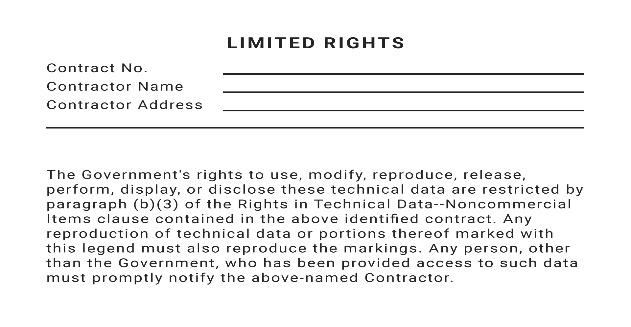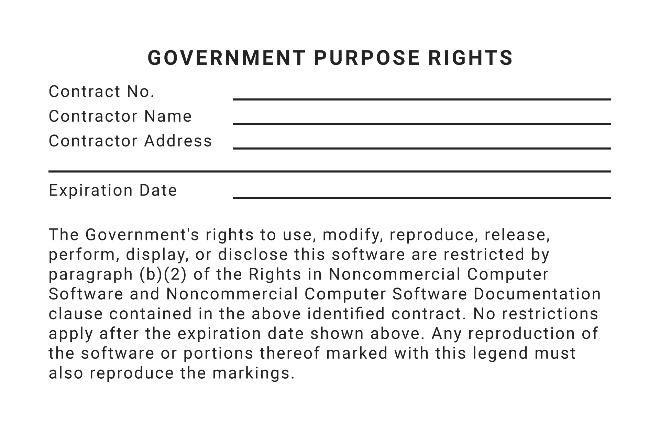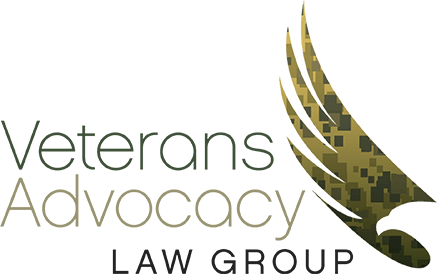Once you have asserted rights restrictions on computer software (CS) and/or technical data (TD) that are required to be delivered under Department of Defense (DoD) contracts, the next step is to mark the TD/CS clearly and visibly with the appropriate markings before delivering it to the Government. Only the markings specified in the Defense Federal Acquisition Regulation Supplement (DFARS) are considered authorized for each type of right for DoD deliverables. Markings that differ from the authorized markings are considered nonconforming markings and can be removed or corrected by the U.S. Government.
Below are the authorized markings for different categories of rights that the Government is granted in non-commercial technical data.
Government Purpose Rights (GPR)

Limited Rights

Legend references paragraphs (b)(2) and (b)(3) from DFARS 252.227-7013.
Specially Negotiated License Rights

Below are the authorized markings for rights for noncommercial computer software.
Government Purpose Rights (GPR)

Restricted Rights

Legend references paragraphs (b)(2) and (b)(3) from DFARS 252.227-7014.
Specially Negotiated License Rights

All the markings mentioned above are authorized and considered "conforming." It is essential to use them verbatim and only fill in the blanks where necessary. Any deviation from the exact wording will make the markings "nonconforming," which may lead to their correction or removal by the Government. As such, contractors are strongly advised not to use creative variations. Note that commonly used markings like "company-confidential," "confidential," or "proprietary” do not conform to DFARS regulations.
If a nonconforming marking is discovered on a mandatory deliverable, the contractor will typically receive a notice informing them of the issue and given a specific time frame to remove or correct the marking. If the contractor fails to remove or correct the marking, the Government can, at its discretion, remove or correct it at the contractor's expense. If the Government chooses to remove nonconforming markings, the contractor's CS/TD may end up without any markings, resulting in the Government obtaining unrestricted/unlimited rights to that CS/TD. Thus, it is advised that the contractor promptly apply the necessary conforming marking that aligns with the assertion level they can support.
A contractor may still place a copyright marking on the CS/TD, even if it intends to grant the Government unlimited rights to the CS/TD by not applying any restrictive rights markings. The extent of the Government's copyright license is co-extensive with its data/software rights. Therefore, copyright markings on CS/TD without any restrictive data or software rights markings provide the Government unlimited copyright and data/software rights. Additionally, should a third party obtain the CS/TD from the Government, copyright markings on unlimited rights CS/TD notifies them of the copyright.
For questions regarding your CS/TD rights assertions documentation and markings, contact us at Veterans Advocacy Law Group. Our team of Government Contracting and Intellectual Property lawyers can examine your markings and ensure they conform to DFARS standards. Additionally, if you have received a notice from the Government regarding nonconforming markings, we will review your submitted CS/TD and help bring the markings up to compliance.


